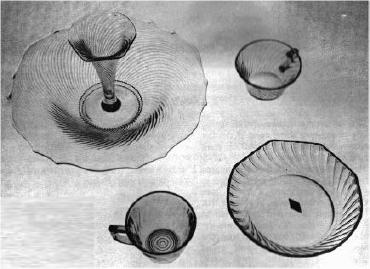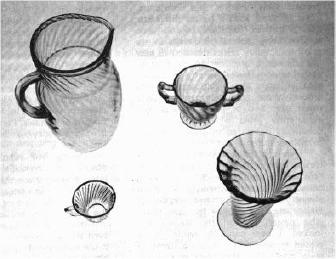National Depression Glass Association
Preserving America's Glass Manufacturing Heritage
The Swirl Family
by Frances Bones
Rainbow Review Glass Journal - May 1973
Almost every glass company that produced colored tableware during the depression years made a Swirl-type pattern. Some of the patterns are quite easily recognized. Others are so similar that positive identification can be made only by those intimately acquainted with the pattern. Upon examining a "new-to-me" piece of Swirl, the first thing I do is turn it over to see if the bottom rim has been ground and polished. In the meantime these thoughts are running through my head - does it have clarity and brilliance? Has it been fire polished? Have the mold marks been removed? If the piece is a goblet or compote - does it have a cast foot? Has this cast foot been tooled? All these things must be taken into consideration to determine if an item was produced for the dime store or jewelry gift shop trade.
 Taking a look at the photo (at right), we see a depression era epergne
that I believe fails into the in between category. It is of fair
quality and could have been the best of dime store glass or the least
expensive line on the jewelry store shelf. The ribs on this piece are
very similar to Federal's DIANA, yet I do not feel it really belongs
with this pattern. Perhaps some of you Rainbow Review of Glass
readers can make positive identification.
Taking a look at the photo (at right), we see a depression era epergne
that I believe fails into the in between category. It is of fair
quality and could have been the best of dime store glass or the least
expensive line on the jewelry store shelf. The ribs on this piece are
very similar to Federal's DIANA, yet I do not feel it really belongs
with this pattern. Perhaps some of you Rainbow Review of Glass
readers can make positive identification.
In the lower right corner is a mold - signed seven inch Heisey nappy, Pattern No. 1241. The color is Flamingo and the added attraction is a paper label showing a pink Flamingo bird. This sticker is the dark diamond showing so prominently on the bottom of the piece. Heisey produced several other items in this swirl pattern.
Hocking Glass Company made an attractive swirl pattern for two or three years only. This pattern is called SPIRAL by depression glass collectors. Pieces of this particular pattern that are shown on these pages are: a cup, pitcher and open sugar, all green in color. The saucer that comes with the cup has no cup ring and could well serve as a dessert plate. The 8¼ inch pitcher has the typical Hocking rope trim, a feature found on both the PRINCESS and CAMEO patterns. Note that this pitcher is shaped differently than the one shown in both the Weatherman and Florence depression glass books. The sugar shown has scroll handles, a design Hocking used on MAYFAIR cream soups and eight ounce pitchers. In the CAMEO pattern, these handles are found on the three inch creamer and sugar, cream soups and some cups.
The cup with a center of concentric circles is Jeanette Glass Company's SWIRL which was also a short lived pattern Also knows as PETAL SWIRL, colors are pink, Ultramarine (aquamarine) and Delfite (blue opaque or blue milk glass). The Delfite pieces I have seen do not have the concentric circle center. There is another swirl pattern (not shown) with a center of concentric circles. Dinner plates are the only pieces I've noted and they appear to be Monax - the coloring and fiery hues are identical to PETAL and AMERICAN SWEETHEART, both MacBeth-Evans Company patterns.
 The demitasse cup shown is crystal gold banded, and was made by
Federal Glass Company. This item is frequently seen with flashed-on
color1ng.
The demitasse cup shown is crystal gold banded, and was made by
Federal Glass Company. This item is frequently seen with flashed-on
color1ng.
The footed vase pictured to the right of the demi-cup is Duncan & Miller SWIRL. The piece is heavy and has been brilliantly fire polished. This pattern was made in a complete table service and several pieces are shown in my new book The Duncan & Miller Glass Book. I was privileged to view a collection of this pattern that filled a built-in china closet from floor to ceiling. It was only then that I fully realized the extent of some of the Duncan lines. Pieces in this SWIRL run the gamut from tall vases to tiny footed compotes (almonds). Leaving nothing to be desired, Duncan even designed relish dishes with matching glass inserts in addition to "nests" of oblong relish dishes available in graduated sizes.
Yes, there are other swirl type patterns waiting to be identified. Remember in the depression years there were hundreds of glass houses operating all in fierce competition for the American dollar. Dealers and collectors working together - perhaps someday all American glass with a pattern will be properly identified. I hope so.